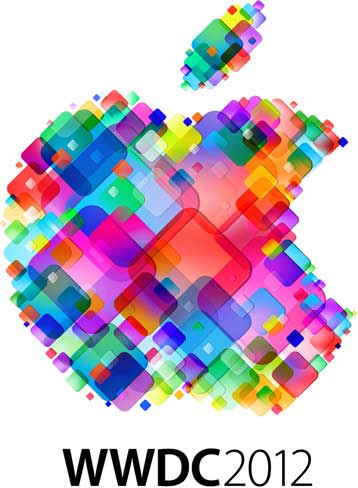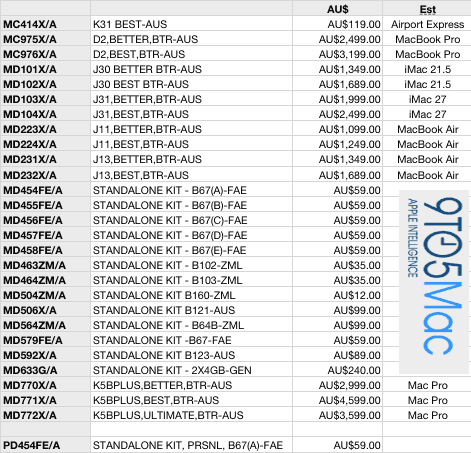 The Worldwide Develop Conference
(WWDC) takes place from Monday, June 11 thorugh Friday, June 15 in San
Francisco.
The Worldwide Develop Conference
(WWDC) takes place from Monday, June 11 thorugh Friday, June 15 in San
Francisco.
Mac notebook and other portable computing is covered in The 'Book Review. iPad, iPod, iPhone, and
Apple TV news is covered in iOS News
Review. All prices are in US dollars unless otherwise noted.
WWDC Anticipation
The Sandboxing Controversy
Software
WWDC Anticipation
After Nearly 2 Years Without an Update, Apple to
Refresh Mac Pro?
9 to 5 Mac's Mark Gurman says that "reliable sources" are reporting
that Apple will unveil a new Mac Pro at WWDC next week and have also
been able to provide some part numbers and prices to prove their
contention, although hardware details are sketchy.
Gurman notes that Apple last
updated the Mac Pro in July 2010, before Apple started using
Thunderbolt on Macs, making this upcoming update especially
significant.
Link: After Nearly Two
Years Without an Update, Apple to Finally Revamp Mac Pro Next
Week
Leaked Apple Inventory List Hints at New Non-iOS
Hardware
The Register's Anna Leach says a leaked Apple inventory list and a
stock shortage are fueling rumors of a new Mac Pro and other Mac
hardware refreshes on deck for Apple's World Wide Developers
Conference.
Leach notes that Apple's pro desktop tower was last refreshed in
2010, but a reported a shortage of Mac Pro stock and an inventory list
leaked to 9 to 5 Mac (above) suggest a new or at least
refreshed Mac Pro model may be on the way, while a purported spec sheet
making the rounds on the Internet appears to suggest a thinner, more
expensive MacBook Pro powered by Intel Ivy Bridge silicon will be
unveiled at WWDC along with iMac and MacBook Air updates.
Link: Leaked Apple
Inventory List Hints at New Non-iOS Hardware
Alleged New Mac Price Sheet Leaked
9 to 5 Mac's Seth Weintraub says the latest claimed Apple inventory
spreadsheet leak reveals a full pricing matrix for new Apple hardware
devices expected to be unveiled next week at the Worldwide Developers
Conference, including Mac Pros, Retina MacBook Pros, MacBook Airs, and
iMacs, as well as optional bits.

New Mac models, part numbers, and Australian prices from 9 to 5
Mac.
Link: New Mac Spec Sheet
Leaks Out, WWDC Launch Pricing and Naming Included
The Sandboxing Controversy
Sandboxing Will Limit Some Mac Apps
MacFixIt's Topher Kessler says many programs available through the
Mac App Store are single-purpose standalone tools and will not be
affected by Apple's sandboxing
requirements, but others will be forced to lose functionality in order
to conform to the new policy. Sandboxing restricts default access to
all system resources except those allowed by specific Apple-defined
entitlements, which is too restrictive for some applications to
function as intended by developers.
Kessler discusses the nuts and bolts of sandboxing and notes that
current implementation on some of Apple's built-in applications has had
its share of quirks, with TextEdit and Preview users having experienced
odd file quarantining flags being appended to files, bizarre crashing
of duplicated application instances as child processes, and the
inability to print or mail PDF documents from print dialogs - an
indicator of the the type of frustrations that may plague users of
applications adopting the current sandboxing implementation.
He observes that in its current implementation, Apple's sandboxing
breaks some common application features and introduces burdensome
additional steps to others, and there are likely to be some instances
where it may greatly affect the user experience with some programs and
the ability of some developers to offer features currently available in
their programs.
Link:
Apple's Sandboxing Restrictive for Some Applications
Sandboxing Strengthens the Case for Buying from the
Developer Instead of Apple
Macworld guest contributor Jonathan 'Wolf' Rentzsch, president of
Red Shed Software Company, notes that since the launch of the Mac App
Store, a question potential customers frequently ask developers is,
"Should I buy your app directly or through the Mac App Store?"
"Developers have been remarkably cagey," he says, "mostly replying
with the non-answer choose whichever is better for you." but now
that Apple now only accepts sandboxed apps to be sold through its
online store, the situation is clarified: "Customers should buy Mac
apps directly unless there's a good reason not to."
That pretty much conforms with what has been your editor's take all
along. I've tried to avoid using the Mac App Store to download software
if there has been any alternative. Examples that come to mind are Bare
Bones Software's excellent TextWrangler text editor and the Sleipnir
Web browser, both of which are available in deeper-featured versions
directly from the respective developer's website than the somewhat
dumbed-down, sandboxed versions available on the Mac App Store. Too bad
more developers haven't make similar alternative provisions.
Rentzsch cites several specific reasons why it's preferable to buy
non-sandboxed apps directly from developers:
- Better App User Experience
- More Features
- Better Data Integrity: noting that Document-based Core Data apps
are incompatible with Sandboxing
- More and Faster Updates
- Less Risk of Losing Your Software Investments, observing that all
things being equal, its safer to buy directly instead of being cut off
from your own software based on an arbitrary Apple policy change.
- More Money Goes to the Developer: Apple takes 30% off the top from
Mac App Store purchases
On the balance, Rentzsch conceded that buying through the Mac App
Store offers a few compensatory benefits:
- Better Purchasing Experience (depends on how you define "better" -
Ed.)
- Better Maintenance Experience: Ergo, if you buy a new Mac, the App
Store app will provide a list of apps you've purchased ready to
reinstall. (Again, the appeal of this depends on how much of a hands-on
machine management control freak you are).
- iCloud Access: According to Rentzsch, Apple has decreed that only
Mac App Store apps (ergo, now sandboxed apps) can access iCloud. Your
non-iCloud-using editor wasn't previously aware of that restriction,
which solidifies my affinity for Dropbox and Box.net for Cloud
utilization.
- Vetted by Apple (If that's important to you)
Anyway, Rentzsch summarizes that the bottom line is that sandboxing
has effectively eliminated ambiguity, and in general he recommends that
customers now purchase apps directly instead of through the Mac App
Store.
Link: Sandboxing
Strengthens the Case for Buying Direct
How Sandboxing Will Affect You
Kirkville's Kirk McElhearn notes that sandboxing, which is now the
rule on the Mac App Store, is unlikely to be noticed by casual Mac
users who do only basic tasks on their computers, but he says that for
those who use more advanced software tools to save time and improve
productivity and efficiency will find ourselves bumping up against this
limit.
McElhearn acknowledges that sandboxing does protect users from rogue
apps, or from apps that, simply because of bugs, can harm the operating
system or essential files, but he contends that users should be able to
choose whether sandboxing is active or not, as with the new Gatekeeper
feature in OS X 10.8 Mountain
Lion, which gives users three choices:
- Allow any application to run
- Allow only applications purchased from the Mac App Store
- Allow any application that has either been purchased from the Mac
App Store or has been signed with an Apple Developer ID (which would be
downloaded from outside the Mac App Store).
McElhearn wonders, Why not do the same for Mac App Store
sandboxing?, suggesting that as currently implemented, sandboxing
may stifle innovation, causing developers to dumb down their apps, or
give up trying to introduce innovative features that need to go outside
the box, He predicts that in the long run, sandboxing will have
negative effects.
Link: How Will Mac App
Store Sandboxing Affect You?
Which Mac Apps Will Be Broken by Sandboxing?
Veteran Mac commentator Andy Ihnatko notes that while the objective
of Apple's sandboxing restrictions isn't a bad goal, in practical terms
many Mac software apps use techniques that are perfectly harmless but
impossible to implement under sandboxing, while others are specifically
designed to deliver systemwide functionality that is fundamentally
incompatible with the sandboxing concept.
Link:
Open Question: Which MacOS Apps Will Be Broken by Sandboxing?
Software
5 Great Free Alternatives to QuickTime
AppStorm's James Cull says that he, like quite a few other Mac
users, is not a huge fan of Apple's QuickTime media software that comes
bundled with OS X. He notes that while QuickTime gets the job done
for some things, he finds its range of codecs and built-in features
limited and inadequate to suit his needs. Happily, Cull notes that
there are plenty of alternatives to QuickTime available, including five
very good free ones:
- VLC Media Player (OS X 10.5 and later, older versions
available)
- MPlayerX (OS X 10.6 and later)
- Plex (OS X 10.6 and later)
- Miro (OS X 10.5 and later, PowerPC supported)
- XBMC (separate Intel and PowerPC versions)
Link: 5 Great (and Free)
Alternatives to QuickTime
Desktop Mac
Deals
Low End Mac updates the following price trackers monthly:
For deals on current and discontinued 'Books, see our 13" MacBook and MacBook Pro,
MacBook Air, 13" MacBook Pro, 15" MacBook Pro, 17" MacBook Pro, 12" PowerBook G4, 15" PowerBook G4, 17" PowerBook G4, titanium PowerBook G4,
iBook G4, PowerBook G3, and iBook G3 deals.
We also track iPad,
iPhone, iPod touch, iPod classic, iPod nano, and iPod shuffle deals.

 The
The 

